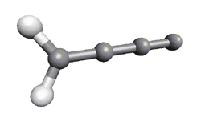|
The experimental data was reported by
(1) T. C. Killian, J. M. Vrtilek, C. A. Gottlieb, E. W. Gottlieb, and P. Thaddeus
1990, Astrophys. J. 365, L89 and
(2) M. J. Travers, W. Chen, S. E. Novick, J. M. Vrtilek, C. A. Gottlieb, and P. Thaddeus
1996, J. Mol. Spectrosc. 180, 75.
There are three Ka = 4 transitions which
afford the inclusion of three parameters to obtain a reduced
standard deviation of the fit comparable to the fit without these lines.
It is conceivable that the assignments are correct, but the
poor reproduction in the fit may be due to Coriolis interaction
of the ground vibrational state with the lowest bending mode.
Therefore, the Ka = 4 transitions have been
omitted from the fit. Consequently, predictions for these lines
as well as higher Ka lines are unreliable
and have been omitted.
The dipole moment is from a quantum chemical calculation.
At low temperatures, it may be necessary to discern between
ortho-l-C4H2
and para-l-C4H2.
The ortho states are described by Ka odd,
the para states by Ka even.
The nuclear spin-weights are 3 and 1 for ortho-l-C4H2
and para-l-C4H2, respectively.
The JKaKc = 111
is the lowest ortho state. It is 9.6947 cm–1 above ground.
|
